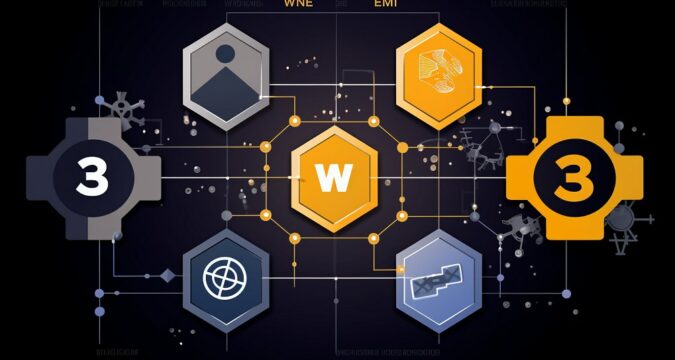
In the world of technology, two terms, “Web3” and “Web 3.0,” have become quite popular. Users often mix them up, but they mean different things.
This guide explores the details of Web3 and Web 3.0, especially what makes them different, including the technologies behind them. It also looks at how they work and their real-life applicability.
Web3: Decentralized And Blockchain-Based
Web3, a term coined by Gavin Wood in 2014, envisions a decentralized web ecosystem free from centralized control. Web3 strives for enhanced security, transparency, and fairness by embracing blockchain technology.
Its core principles revolve around decentralization, leveraging a globally distributed computer network, blockchain-based infrastructure, and cryptocurrencies to ensure security and resist censorship.
Web 3.0: Semantic And Intelligent
Contrastingly, Web 3.0, coined by Tim O’Reilly in 2006, focuses on a more intelligent and connected web facilitated by semantic web technologies. This paradigm aims to enable machines to comprehend the meaning of data, fostering a more intelligent web where interactions are intuitive.
It emphasizes semantic web principles to render data machine-readable and interconnected.
Web3 Principles: Decentralization And Cryptocurrencies
Web3 thrives on decentralization, powered by a distributed network of computers and blockchain technology. Cryptocurrencies play a pivotal role within this ecosystem, offering value units in a decentralized environment suited for various applications, including financial transactions and supply chain management.
Web 3.0 Principles: Semantic And Connected
Web 3.0 emphasizes a semantic web that facilitates machine data understanding and enhanced platform connectivity. This principle aims to enable easier data sharing, linkages between different platforms, and an open, transparent web accessible to all.
Distinguishing Web3 From Web 3.0
The fundamental disparity between Web3 and Web 3.0 is more profound when exploring their core focus and the technologies driving their evolution.
Focus: Decentralization vs. Intelligence
Web3’s core ethos revolves around breaking away from the centralized control of information and services. By leveraging blockchain technology, Web3 ensures that no single entity governs the network.
This decentralized nature fosters a more secure, transparent, and equitable digital environment. The emphasis is on achieving robustness against censorship, providing a platform where data and transactions are distributed across a network of computers worldwide.
Contrarily, Web 3.0 emphasizes the evolution towards an interconnected web. The pivotal objective here is to enhance the web’s capabilities for better data comprehension and interoperability.
This vision aligns with the semantic web concept, where data is structured to be machine-readable, facilitating the extraction of context and meaning. By fostering connectivity and intelligence, Web 3.0 aims to create a more intuitive user experience and enable innovative applications driven by machine understanding.
Technologies: Blockchain Vs. Semantic Web
Web3 has its roots in blockchain technology, the backbone of its decentralized structure. Blockchain serves as a distributed ledger system, recording transactions transparently and tamper-proof.
It leverages cryptographic principles and smart contracts to ensure trust and security. Smart contracts enable automated and self-executing agreements stored on the blockchain, fostering trustless interactions between parties.
In contrast, Web 3.0 gravitates towards semantic web technologies to realize its vision of an intelligent web. This evolution encompasses artificial intelligence (AI), machine learning, and natural language processing (NLP).
These technologies enable machines to analyze, understand, and respond to data with human-like intelligence. Semantic web technologies focus on structuring data so that machines can derive meaning and context from it, enabling sophisticated searches, interactions, and information processing.
Current State And Future Prospects
Web3 is still evolving, primarily based on blockchain technology, while Web 3.0 remains a conceptual framework under research and development. Combining decentralized Internet of Things (IoT) and AI technologies holds promise for building an intelligent and interconnected web.
Applications Of Web3 And Web 3.0
Web3 and Web3.0 have found several use cases in modern businesses.
Web3 Applications
Non-fungible Tokens (NFTs): Unique digital assets representing ownership.
Decentralized Finance (DeFi): Enables financial activities without central authorities.
Decentralized Autonomous Organizations (DAOs): Organizations governed by smart contracts.
Web 3.0 Applications
Voice Assistants such as Siri and Alexa for intelligent responses.
Semantic Search Engines enhance search results using data understanding.
Ending Thoughts
Some industry observers believe that Web3 and Web 3.0’s distinct focuses will persist, while others anticipate a merging as technologies evolve. Nevertheless, their trajectory will depend on user adoption, regulations, and technological advancements.
Thus, an open mind is essential in understanding these concepts’ potential future paths.










